Updated: January 31, 2025
Written by Adam Graham
Cristina has more than 4 years of experience in the remodeling and home design sector. She joined Fixr.com in 2017 and has since been working constantly with industry experts to bring the most accurate and reliable information regarding news, trends, and advice to homeowners and other industry pros. Her work has appeared in major industry publications, like Forbes, Realtor.com and the official publication of the National Kitchen & Bathroom Association.
Learn moreReviewed by Cristina Miguelez
A video surveillance system helps you ensure that your home is safe and that you always know what is going on. When installing video surveillance systems, you protect your valuables and deter crime in and around your home. It provides remote access monitoring for peace of mind, lower insurance premiums, and other perks. There are a host of surveillance systems available today. Sometimes called Closed Circuit Television, or CCTV, these systems are ideal for helping you keep an eye on your home even when you are not there.
The average homeowner spends $400 to $800 installing video surveillance cameras in their home. On average, homeowners pay about $600 to install four or more wireless cameras, a recording system, and Cloud and Smart capabilities. At the low end, homeowners can purchase and install a doorbell camera for about $150. At the high end, it costs as much as $2,000 to install 12 or more wired cameras with premium features and a year of professional monitoring.
Security Cameras Installation Prices
| Surveillance Camera Installation Cost | |
| National average cost | $600 |
| Average range | $400-$800 |
| Low-end | $150 |
| High-end | $2,000 |
Surveillance Camera Cost by System Type
You can expect to spend between $500 and $2,000 on the purchase and installation of your surveillance system based on whether it is wired or wireless, or $300 to $600 on cameras and equipment alone. In surveillance systems, wired systems, also sometimes known as analog CCTV systems, are one option, while wireless systems, known as internet protocol or IP systems, are another. The terms wired and wireless refer to how cameras send information, with wired cameras sending their footage and information over cabled connections, and wireless cameras doing so over WiFi. Both wired and wireless cameras usually receive their power via wired connections. Depending on your individual security needs, both wired and wireless systems have advantages and disadvantages to consider.
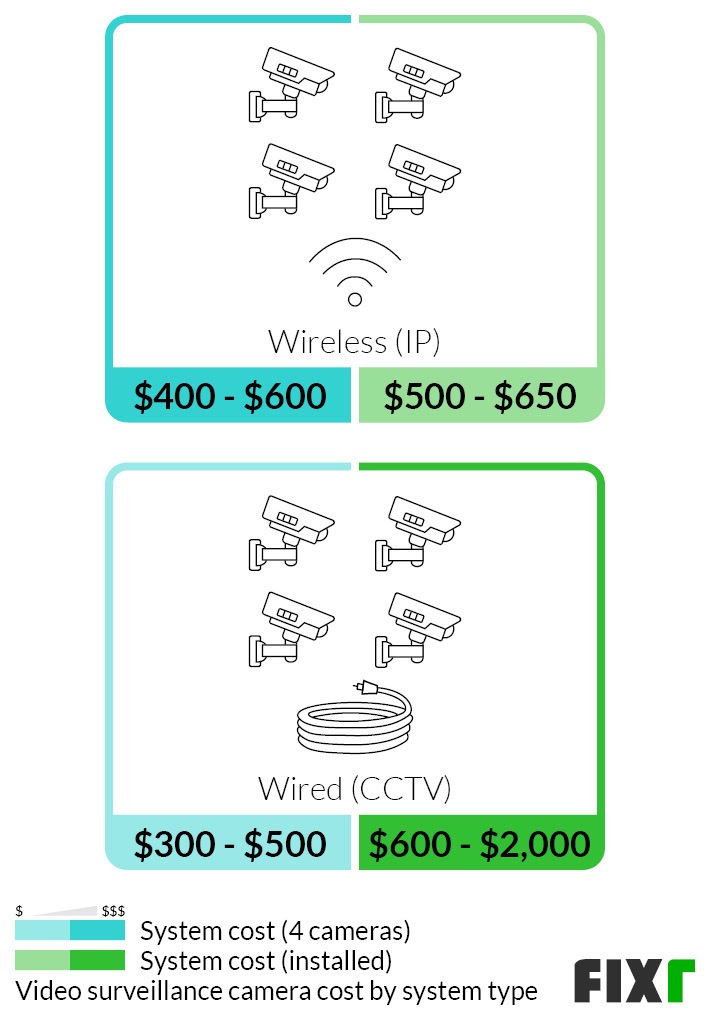

| System Type | 4 Camera System Price (Unit Only) | 4 Camera System Price (Installed) |
| Wireless (IP) | $400 - $600 | $500 - $650 |
| Wired (CCTV) | $300 - $500 | $600 - $2,000 |
Wireless Camera Cost or IP Camera
Wireless or IP cameras average $100 to $150 each, with a set of 4 averaging between $400 and $600 without installation. The installation of IP cameras can be done DIY or by a professional, ensuring proper installation. This costs an additional $50, depending on the work required, and the total materials and installation cost is usually between $500 and $650.
Wireless cameras refer to cameras that transmit footage via the internet as opposed to cables. Wireless cameras typically receive their power via a cabled Ethernet, or Cat 5e, wire connections. These cameras are usually much easier and more flexible to set up, are more user friendly, and offer increased software features for Cloud connectivity and reviewing footage. However, wireless cameras carry security and reliability drawbacks, such as a reliance on WiFi connection and a susceptibility to hacking. For example, not only can your camera feeds be disrupted if the WiFi signal goes out, but they can also be hacked by online criminals attempting to view your camera feeds.
An important distinction between the terms IP camera and wireless camera is that while most companies and homeowners use these terms interchangeably, some brands use the terms to refer to two different kinds of cameras. In this case, the term IP cameras refers specifically to cameras that transmit their footage via the cabled Ethernet internet connection. In contrast, the term wireless camera refers to those that transmit footage via a wireless WiFi internet connection. In contrast, the term “wireless camera” refers to those that transmit footage via a wireless WiFi internet connection. As Cloud technology and other solutions change the market, wired IP cameras are being phased out. It is becoming generally accepted that wireless and IP cameras are essentially the same thing.
Wired Camera Price or CCTV Camera
Wired or analog CCTV cameras average between $75 and $125 each, with a set of four averaging $300 to $500 without installation. The installation of CCTV cameras costs an additional $300 to $1,500 or more depending on the work required, making the total materials and installation cost fall between $600 and $2,000.
Wired or CCTV cameras are generally more reliable and secure than wireless cameras because they are not dependent on an internet connection and much less prone to hacking. Wired cameras transmit their video feeds through cables or wires to a storage unit like a VCR, hard drive, or DVR. Wired cameras typically require coaxial cables, also known as Siamese or shotgun cables, to function. These systems have lower price points, have a more consistent video quality, can be more reliable, and are a good choice for homeowners wanting a security solution for larger spaces. On the other hand, they require professional installation, tend to have poorer internet integration, fewer Smart features, and less user-friendly software.
Surveillance Camera Price by Camera Type
The average cost of a single surveillance camera ranges from $10 to $700 just for the unit and between $80 and $900 installed, depending on the type of camera you choose. Surveillance cameras come in many varieties for use in different purposes and situations. Factors like footage quality, internet capabilities, and setup flexibility differentiate the many models on the market. Since prices and features vary widely, understand the different model types to choose the right camera for your needs.
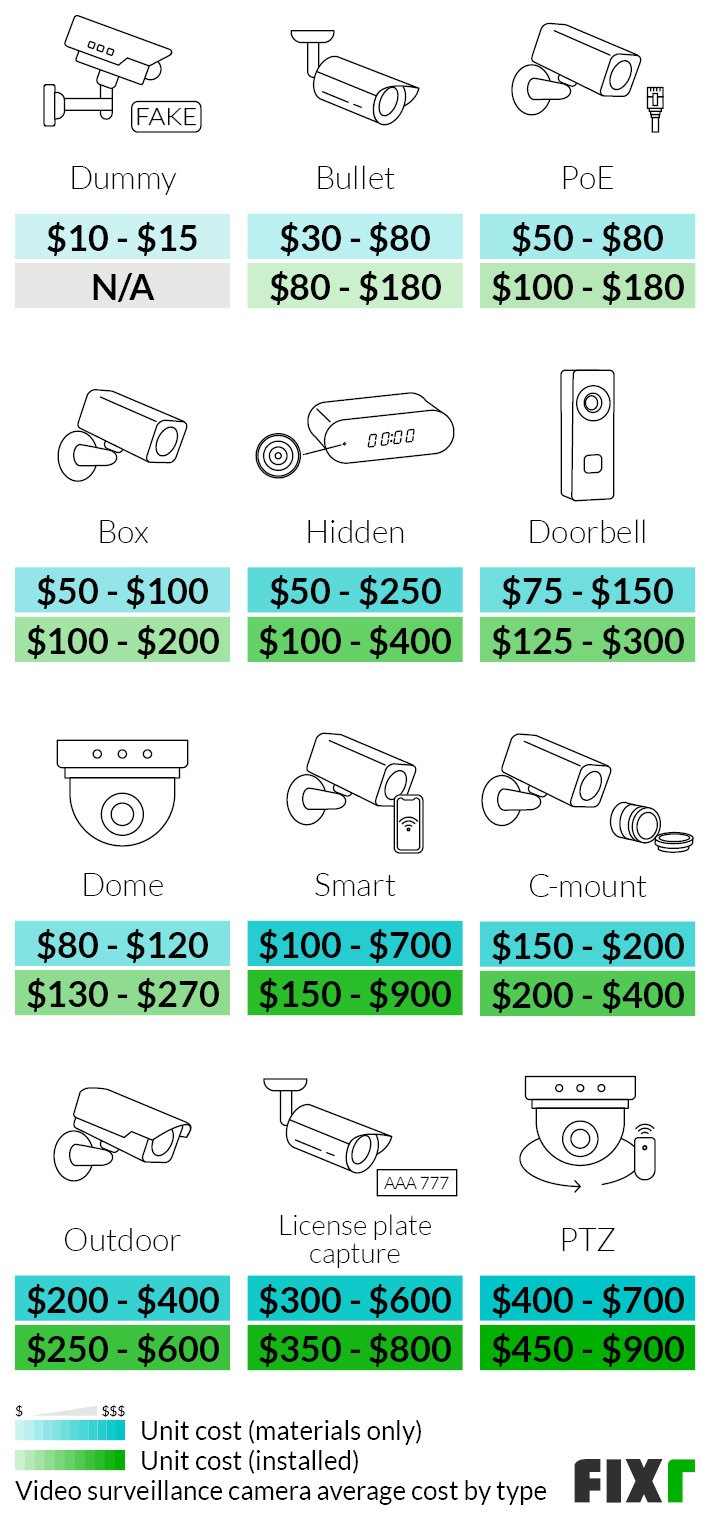

| Type | Cost (Unit Only) | Unit Cost (Installed) |
| Dummy | $10 - $15 | N/A |
| Bullet | $30 - $80 | $80 - $180 |
| PoE | $50 - $80 | $100 - $180 |
| Box | $50 - $100 | $100 - $200 |
| Hidden | $50 - $250 | $100 - $400 |
| Doorbell | $75 - $150 | $125 - $300 |
| Dome | $80 - $120 | $130 - $270 |
| Smart | $100 - $700 | $150 - $900 |
| C-Mount | $150 - $200 | $200 - $400 |
| Outdoor | $200 - $400 | $250 - $600 |
| License Plate Capture | $300 - $600 | $350 - $800 |
| PTZ | $400 - $700 | $450 - $900 |
Dummy Camera
Dummy cameras cost from $10 to $15 on average. They are fake cameras that do not actually record footage, but they give the appearance of a functioning surveillance system. While these cameras come with the obvious drawback of not offering any actual surveillance capabilities, they are very cheap and require virtually no setup. Many come with realistic flashing lights to give the appearance of an actual functioning system, making dummy cameras a potential choice for homeowners looking for a cheap solution to deter criminals.
Bullet Camera
Bullet cameras are a budget-friendly surveillance camera option and range from $30 to $80 each without installation and $80 to $180 installed. A bullet camera is similar to a box camera. However, like a dome camera, its lens is permanently fixed inside a glass housing. These cameras are more discreet and come in indoor and outdoor varieties, but it can be difficult to reposition and perform maintenance due to the permanent nature of the housing. Bullet cameras are compatible with CCTV or IP systems.
PoE Surveillance Camera
PoE cameras cost $50 to $80 per unit and $100 to $180 installed. PoE, or power-over-Ethernet cameras, are cameras that receive their power via an Ethernet connection as opposed to a coaxial, other cable type, or batteries. A benefit of these cameras is that it may reduce installation costs if you already have Ethernet cables in your home. . PoE cameras are compatible with CCTV or IP systems.
Box Camera
Box cameras cost an average of $50 to $100 each and $100 to $200 installed. Box cameras generally refer to cameras with a box-like body that is attached to a separate lens. These cameras tend to be somewhat more bulky, expensive, and less visually pleasing than other types. But they usually come with improved performance and product life and the opportunity to change lenses. They may be an option for homeowners looking for a higher security presence. Box cameras are compatible with CCTV or IP systems.
Hidden Camera
Hidden cameras range from $50 to $250 each and $100 to $400 installed. They differ from other camera types in that they usually do not physically look like cameras. Hidden cameras are often either disguised as other appliances like smoke detectors or clocks or are exceptionally small to avoid detection. These features make them great options for discreet surveillance, but their small sizes and unusual shapes can sometimes mean limitations on footage quality and memory space. Hidden cameras are compatible with CCTV or IP systems.
Doorbell Camera
Doorbell cameras are becoming more popular and cost $75 to $150 without installation and $125 to $300 installed. Doorbell cameras combine camera technology with traditional doorbell features to allow you to survey the area in front of your home’s door. They can capture both audio and video during the day or at night via infrared LED sensors or a spotlight, a speaker and a microphone. Doorbell cameras typically offer Smart features like smartphone alerts when someone rings the doorbell or movement is detected. Like other wireless cameras, these doorbell cameras require a dependable WiFi signal to transmit data. Doorbell cameras can be compatible with CCTV or IP systems, but are mostly used with IP systems.
Dome Camera
Dome camera prices range from $80 to $120 each and $130 to $270 installed. Dome cameras get their name from the transparent, dome-shaped glass housing that surrounds the lens.The benefits of dome cameras are that they are discrete in appearance, resistant to vandalism due to the protective glass, and it is hard to tell which direction the lens is pointing. However, this glass casing can mean it is difficult to access the lens to reposition it or perform maintenance. Dome cameras are compatible with CCTV or IP systems.
Smart Home Security Camera
Smart security cameras allow you to keep an eye on your home from anywhere. They cost between $100 and $700 without installation and $150 to $900 installed, depending on the brand and features. Most of them detect movement and notify the user of any unexpected activity. Smart home security cameras are increasing in popularity. Smart services like Google Assistant, Amazon Alexa, and many others now support integration with many cameras. These cameras can be more expensive, especially Google and Amazon’s own special cameras. But other Smart home integrated cameras are priced very reasonably.
C-Mount Camera
C-mount cameras usually run $150 to $200 each and $200 to $400 installed. C-mount cameras refer to cameras intended to be used with lenses that are 1 inch in diameter, also known as C-mount lenses, one of the most common CCTV lens types. The term C-mount is a fairly widespread camera term that refers to any camera that uses a standard 1-inch mount, and they are common for both videography and security purposes. As a result, these cameras come in a very wide variety and are generally similar to box cameras. C-Mount cameras are compatible with CCTV or IP systems.
Outdoor Security Camera
Outdoor security cameras range from $200 to $400 without installation and $250 to $600 installed. Outdoor security cameras are security cameras with additional features geared toward outdoor functionality, usually including weatherproof casings and low-light functionality. As a result of these enhanced features, outdoor security cameras may be more expensive than other models. Outdoor security cameras are compatible with CCTV or IP systems.
License Plate Capture Camera
These cameras average $300 to $600 without installation and $350 to $800 installed. License plate capture cameras refer to cameras capable of capturing images of high enough quality to see and read license plate numbers. It is important to note that cameras described with this term may or may not include software capable of auto-reading numeric data. Many cameras marketed as license plate capture cameras simply refer to cameras with image quality sharp enough to see numbers upon footage review. License plate capture cameras are compatible with CCTV or IP systems.
PTZ Camera
PTZ cameras cost from $400 to $700 each and $450 to $900 installed. PTZ, or pan-tilt-zoom cameras, are remote-controlled cameras capable of moving, swiveling, and zooming the lens. Many people love these cameras because they are easily adjustable. Many even include auto-adjusting software that simplifies it even further. PTZ cameras are compatible with CCTV or IP systems.
Security Camera Cost by Resolution
You can expect to spend between $30 and $1,000 on security cameras just for the unit and between $80 and $1,200 with installation included, based on their resolution. The term resolution refers to the size, or detail, of the image that a camera produces. While it is not the only factor in image clarity, resolution can be important for surveillance cameras because the more detail your camera captures, the more you can see what exactly is going on in your footage. The larger the space in your home you want to survey, the larger the resolution you may want to consider for sharper detail over distance. However, as resolution increases, so do both price and the memory storage space required.


| Resolution in Megapixels | Cost (Unit Only) | Unit Cost (Installed) |
| 1 MP (720 pixels) | $30 - $60 | $80 - $160 |
| 2 MP (1080 pixels) | $40 - $100 | $90 - $200 |
| 4 MP (1440 pixels) | $80 - $200 | $130 - $350 |
| 6 MP (2048 pixels) | $100 - $250 | $150 - $400 |
| 8 MP (4K/2160 pixels) | $150 - $300 | $200 - $500 |
| 10 MP (2592 pixels) | $200 - $400 | $250 - $600 |
| 12 MP (2800 pixels) | $800 - $1,000 | $850 - $1,200 |
1MP Security Camera
1MP security cameras have an average cost between $30 and $60 without installation and between $80 and $160 installed. 1MP cameras, also known as 1-megapixel cameras, are cameras on the lower end of security systems. These cameras are usually much cheaper than those with higher resolutions and can be a great choice for homeowners looking for a basic security option. However, footage from 1MP cameras may not have much clarity for purposes like facial and number recognition.
2MP Security Camera
2MP, or 1080p, CCTV camera prices range from $40 to $100 each and from $90 to $200 installed. 2MP cameras, also known as 2-megapixel or 1080p CCTV cameras, generally tend to be the standard starting point for HD-quality security cameras. These cameras offer resolution good enough for facial recognition up to 30 feet and a wide 80-degree viewing angle. However, they do not offer the clarity that comes with some higher resolutions.
4MP Surveillance Camera
4MP cameras average between $80 and $200 without installation and between $130 and $350 installed. 4MP cameras, also known as 4-megapixel security cameras, offer 30% more pixels than industry-standard 2MP cameras. This means they can offer image quality good enough to capture facial features from up to 50 feet away and an 84-degree viewing angle. One drawback is that as resolution increases, the price and memory storage required for this high-quality footage also increases.
6MP Security Camera
6MP camera prices range from $100 to $250 without installation and from $150 to $400 installed. 6MP cameras, also known as 6-megapixel security cameras, mark the beginning of higher-end resolution options for security cameras. 6MP cameras offer increased detail captures like facial recognition from 70 feet in good light conditions and wider viewing angles. One drawback is resolutions of this quality may be insufficient for larger spaces.
8MP Security Camera
8MP cameras, also known as 4K security cameras, cost between $150 and $300 each and between $200 and $500 installed. These cameras offer a very high resolution capable of producing 4K footage, or footage with 8.3 million pixels. These cameras are a good choice for homeowners looking to survey larger areas at a greater distance without losing detail like outdoor areas. On the other hand, 8MP cameras require higher bandwidth and storage space. These cameras with 8MP resolution and higher are generally geared toward larger industrial, business, and commercial spaces.
10MP Security Camera
10MP cameras average $200 to $400 each and $250 to $600 installed. 10MP cameras, also known as 10-megapixel cameras, offer extremely high image resolution capable of capturing detail at distances of over 100 feet in good light conditions. Cameras with 10MP resolution or more are typically used on large properties to survey very large areas without sacrificing quality. A drawback is that they require extremely large memory spaces and bandwidth, and since this resolution is just one tier lower than the industry-best 12MP, it may be difficult to find standardized 10MP setups.
12MP Security Camera
12MP cameras range from $800 to $1,000 or more each without installation and from $850 to $1,200 installed. 12MP, also known as 12-megapixel cameras, offer some of the absolute highest image resolution of security cameras on the market today. These cameras capture very large amounts of image detail and are often used in situations like large stadiums, airports, and military bases. As with other high-resolution cameras, they require extremely large amounts of storage space and are among the costliest models on the market.
Home Security Camera Price by Field of View
You will spend between $30 and $800 without installation and between $80 and $1,000 installed on cameras based on their field of view. Along with resolution, field of view is one of the most important factors in determining if the image your camera produces satisfies your distance and detail needs. Field of view can be measured in lens millimeters or angle degrees. Generally, larger lenses produce a tighter field of view but with more detail over a longer viewing distance. Smaller lenses, also known as wide-angle lenses, produce a wider field of view but are limited to shorter distances. When choosing a field of view, it is important to consider whether capturing a wider angle or a more detailed, particular area is desired.
Larger numbers generally refer to a smaller field of view. For example, in a 12mm or 8mm camera, you may only have a 22- to 33-degree angle. On a 2.8mm camera, however, you could have a 90-degree view that offers much more visibility. You need to be careful when considering the field of view compared to the degree and the placement of the camera because sometimes, a wider field of view distorts the image. The smaller the field of view, the better it is for short distances. Modern high-end 180- or 360-degree cameras often eliminate the need for multiple units.

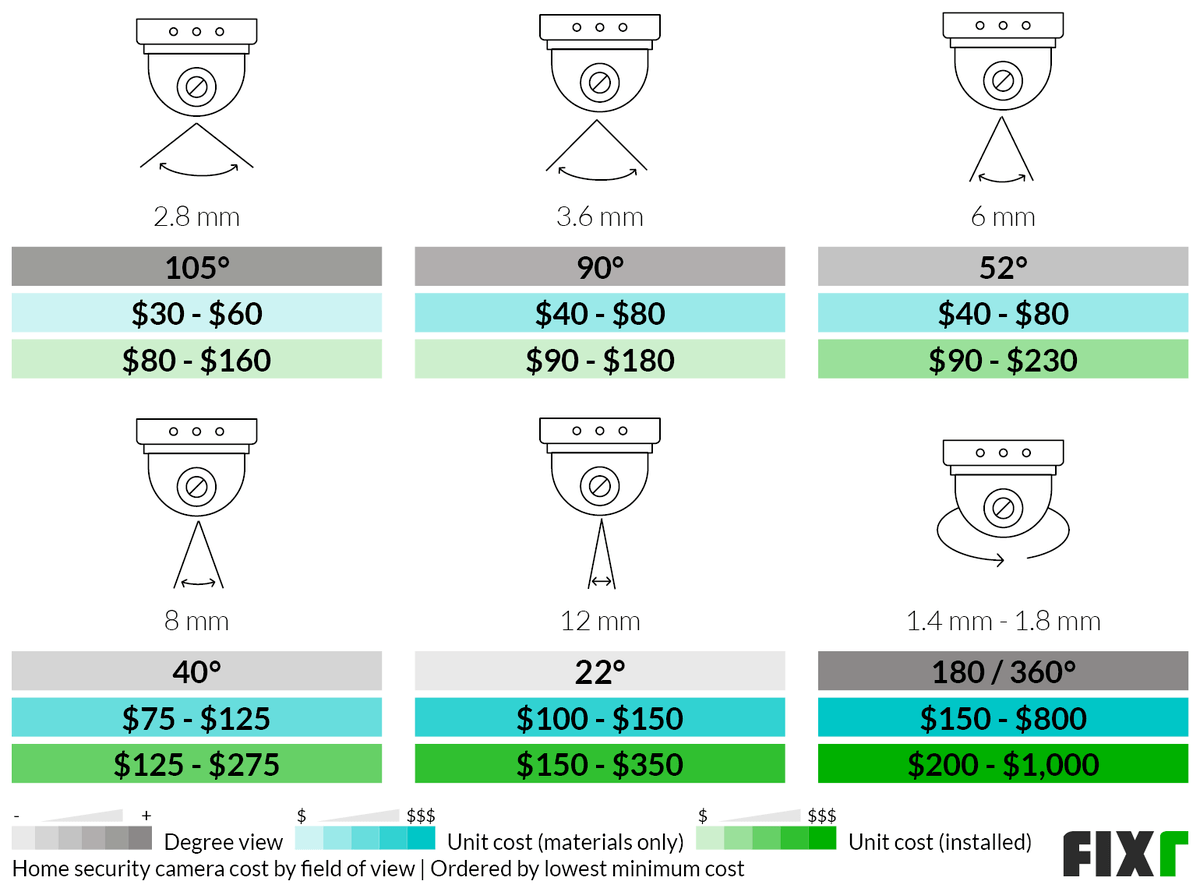
| Field of View | Degree View | Cost (Unit Only) | Cost (Installed) |
| 2.8 mm | 105º | $30 - $60 | $80 - $160 |
| 3.6 mm | 90º | $40 - $80 | $90 - $180 |
| 6 mm | 52º | $40 - $80 | $90 - $230 |
| 8 mm | 40º | $75 - $125 | $125 - $275 |
| 12 mm | 22º | $100 - $150 | $150 - $350 |
| 1.4 mm - 1.8 mm | 180/360º | $150 - $800 | $200 - $1,000 |
Cost of Home Security Cameras by Frame Rate
Based on their frame rate, you will spend $30 to $150 on surveillance cameras without installation and $80 and $350 installed. Video is essentially a series of still images, or frames, that when viewed together give the impression of a moving image. Frame rate refers to how many frames are shown, usually measured in frames per second (FPS). Frame rate is important to consider when buying a security camera, as a higher FPS will result in more detailed footage. On the other hand, the higher the FPS, the higher the memory storage required, and the higher the price of the camera. 15, 30, and 60 FPS security cameras are some of the most common types on the market today.

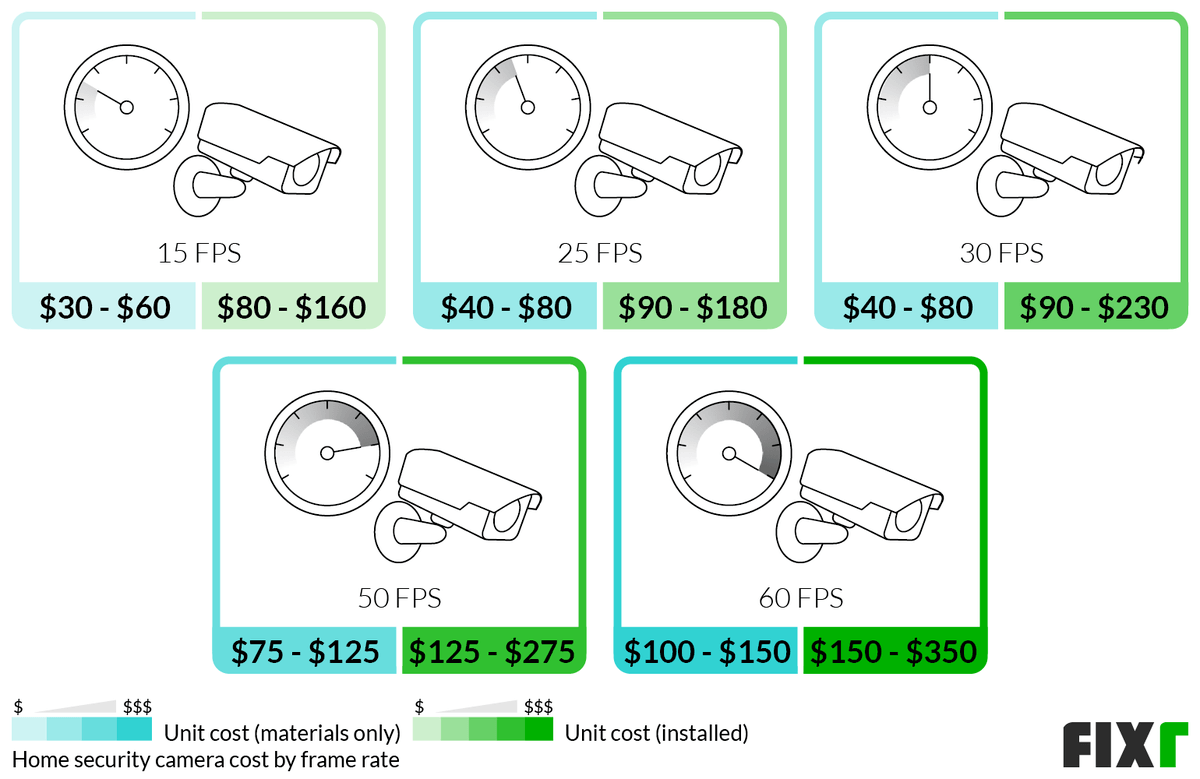
| Frames per Second (FPS) | Cost (Unit Only) | Cost (Installed) |
| 15 FPS | $30 - $60 | $80 - $160 |
| 25 FPS | $40 - $80 | $90 - $180 |
| 30 FPS | $40 - $80 | $90 - $230 |
| 50 FPS | $75 - $125 | $125 - $275 |
| 60 FPS | $100 - $150 | $150 - $350 |
Surveillance Camera Cost by Brand
When shopping by brand, you will spend between $20 and $400 for the unit and between $70 and $700, including installation, for the cameras you choose. A security camera’s brand goes a long way toward determining its quality, durability, and effectiveness. Based on your individual needs, certain brands may be more or less desirable, depending on not just the product, but also the warranty, installation, and other services they offer. These are all important things to consider when choosing your camera’s brand.


| Brand | Cost (Unit Only) | Unit Cost (Installed) |
| Q-See | $20 - $30 | $70 - $130 |
| Optica | $60 - $90 | $110 - $190 |
| Swann | $70 - $100 | $130 - $200 |
| Night Owl | $100 - $150 | $150 - $300 |
| Dahua | $100 - $200 | $150 - $350 |
| Lorex | $125 - $175 | $175 - $325 |
| Hikvision | $125 - $200 | $175 - $400 |
| Nest | $150 - $300 | $200 - $700 |
| Vivint | $225 - $275 | $275 - $475 |
| Sony | $300 - $400 | $350 - $600 |
Q-See Security Camera
Q-See security cameras cost $20 to $30 each and $70 to $130 installed. Q-See is an American security brand that offers a range of cameras, NVRs, hard drives, and cabling. Q-See’s cameras, which include both basic wired and wireless options, are priced very reasonably, and several include features like motion detection and Google Assistant/Amazon Alexa integration.
Optica Security Camera
Optica cameras cost $60 to $90 each and $110 to $190 installed. Optica security cameras come in bullet, dome, and PTZ varieties. Optica also offers a special vandal-resistant dome camera designed to resist attacks intended to disable the camera. Optica offers a wide range of additional solutions and has provided security solutions to organizations like NASA and the U.S. Air Force.
Swann Camera
Swann camera prices range from $70 to $100 without installation and from $130 to $200 installed. Swann is an Australian security brand offering a fair-sized range of camera options, including dome, bullet, and floodlight styles. Swann cameras also come in wired and wireless varieties, and several feature integrated lights as well as Google Assistant/Amazon Alexa support. Swann cameras can be a good middle-of-the-road option, coming with high resolution and features relative to their price.
Night Owl Security Camera
Night Owl cameras cost $100 to $150 without installation and $150 to $300 installed. Night Owl security cameras come in bullet and dome forms. Many Night Owl security cameras feature enhanced night vision features, and some are also equipped with heat-detection features. Night Owl cameras are best known for these features and are especially well-suited to outdoor, long-range, or exceptionally low-light situations.
Dahua Security Camera
Prices for Dahua cameras vary significantly, with the company offering a Lite, Pro, and Ultra Series. Their cameras cost $100 to $200 each and $150 to $350 installed. Dahua is a Chinese security brand that offers a very wide range of cameras, including dome, bullet, PTZ, and license plate recognition. They also offer an extensive additional product lineup of DVRs, NVRs, cabling, and Smart home integration features. In addition, Dahua also offers a customer support hotline.
Lorex Security Cameras
Lorex cameras prices range from $125 to $175 each and $175 to $325 installed. Lorex is a Chinese security brand that offers a high-quality range of wired and wireless cameras for home, business, and commercial uses. Lorex offers bundle-style packages including multiple cameras and NVRs with high resolution relative to price, as well as other items like doorbell and wire-free cameras.
Hikvision Camera
Prices for Hikvision cameras vary significantly. This brand’s cameras cost $125 to $200 each and $175 to $400 installed. Hikvision is another Chinese security brand with an extensive range of camera options, including dome, bullet, PTZ, and license plate recognition. Hikvision offers several lines of products tailored to specific security purposes. For example, they have cameras with deep-learning algorithms, cameras that capture color in low light, and even explosion-resistant cameras. Hikvision also offers DVRs, NVRs, and cabling.
Nest Camera
Nest cameras cost between $150 and $300 without installation and between $200 and $700 installed. Nest cameras operate as part of the Google Home system of products and include four camera varieties: normal and Smart cameras in indoor and outdoor varieties. For homeowners interested in smart AI features like Google Assistant integration, microphone communication abilities, and automatic Smart alerts when sounds and movements are detected, these cameras stand far out from the rest.
Vivint Camera
Vivint cameras cost $225 to $275 without installation and from $275 to $475 installed. Vivint offers three Smart features-oriented cameras: outdoor, indoor, and doorbell models. In addition, Vivint offers home automation products like Smart thermostats and control hubs, which integrate with cameras and smartphones for a high level of control. Vivint cameras and systems have built-in around-the-clock automatic emergency services monitoring, which take your home security system beyond individual camera units to a Smart system that assists in the event of a break-in.
Sony CCTV Camera
Sony cameras cost $300 to $400 without installation and $350 to $600 installed. Sony offers a wide range of analog and IP-style surveillance cameras in the bullet, PTZ, and dome forms. In addition, Sony’s catalog of products also includes accessories for mounting and speaker communications. Sony’s cameras come with the support and reliability of the large brand but also the high price.
Security Camera Labor Costs
Of the average $400 to $800 it costs for surveillance cameras, about $50 to $200 is labor, with the remaining $350 to $600 going toward the cost of the cameras. Many factors determine the labor cost of security camera installation. One is whether you are installing a wired or wireless system. The installation locations also impact how much labor you pay. Typically, electricians or electronics professionals install these cameras. Some companies have their own technicians install the systems, which could come at a premium cost. On the other hand, you could purchase the materials and hire your own installer to save a little money.
Most professionals charge per camera or installation point. However, some may charge by the hour at $50 to $75 per hour. Some may charge a flat rate per job, such as $200 to install four basic security cameras with all wiring and accessories provided by you. To install cameras, you may also need cables, power supplies, and monitors to view the security footage. This incurs an additional installation cost. You can work with your installer to determine the most cost-effective option and exactly how many cameras you need to install, depending on your budget and the type of protection you want around your home. The number of cameras you need to install depends on how much area you need to cover. If you want to monitor all four sides of your home, with blind spots, for example, you could need between four and six mid-range cameras. This is where the assistance of an expert comes in handy.
CCTV Installation
Installing a wired security system averages from $300 to $1,500, making the total cost of materials and installation between $500 and $2,000. Since wired systems generally require more cords, drilling, and installation processes, costs of installing a wired system are relatively higher. If you have an Ethernet line in your home already, it will reduce the overall cost of a wired system significantly by eliminating much of the installation cost. CCTV systems are typically installed by the security company, which offers the cameras and equipment, or in some cases by contractors.
Wireless Camera Installation
Depending on installation needs, wireless installations generally cost much less, around $50 due to minimal labor, which means the total cost of materials and installation of a wireless system costs $400 to $900, depending on the setup. Wireless cameras often have simpler installations because no cabling is required. This lowers the installation cost, but you might spend more on the cameras themselves. Installation by professionals may be a good option to ensure the best performance from your system.
Security Camera Storage Price by Storage Type
You can expect to spend between $30 and $400 on traditional storage, depending on the type, or $15 to $30 per month for a cloud-based storage solution. An important factor in setting up a surveillance camera system is how the footage captured by the cameras is stored. These storage methods range from physical copies like SD Cards and Digital Video Recorders (DVRs) to internet-based solutions like Cloud storage and hybrid methods like network video recorders (NVRs). Considerations when choosing between storage systems include how accessible the footage will be via internet and mobile, and whether or not you will only have to pay a one-time fee, as with memory cards, or a recurring monthly one for Cloud-based services.
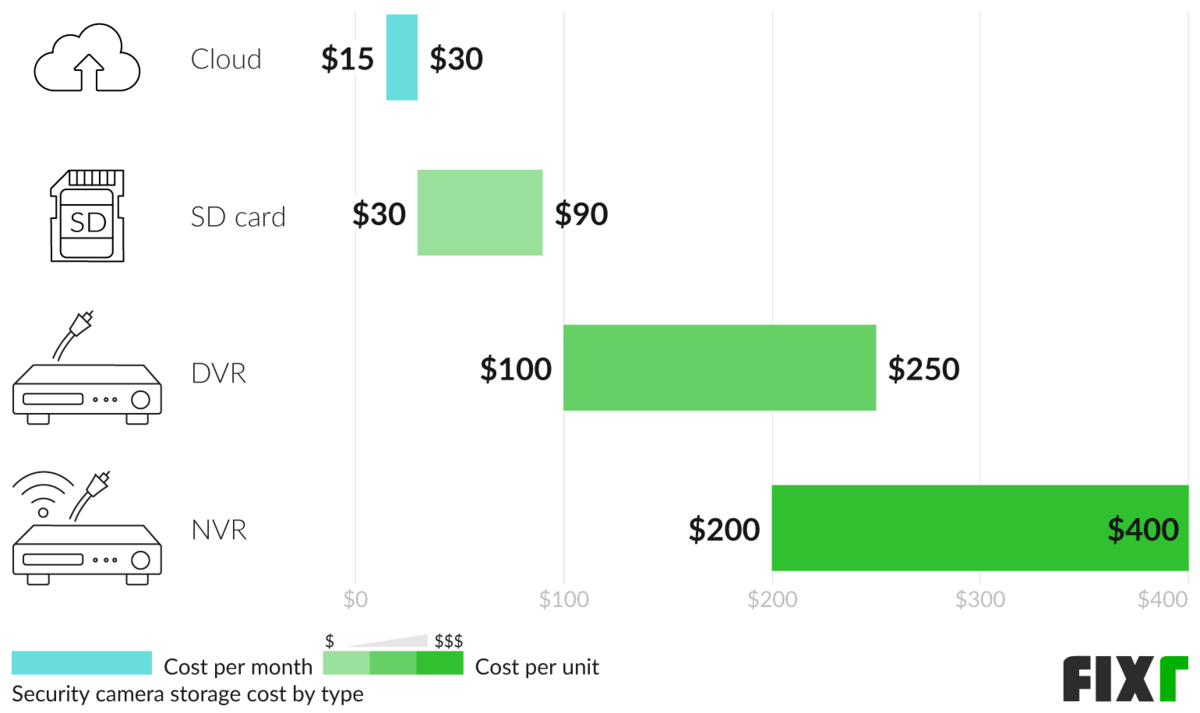
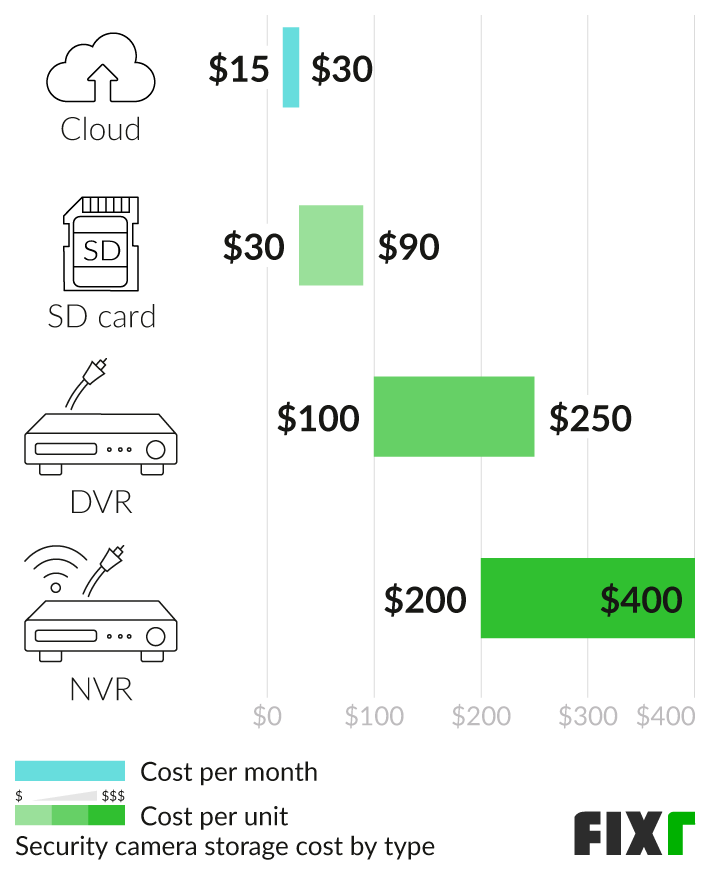
| Type | Storage Cost |
| Cloud | $15 - $30/month |
| SD Card | $30 - $90/unit only |
| DVR | $100 - $250/unit only |
| NVR | $200 - $400/unit only |
Security Camera Cloud Storage
Cloud storage costs $15 to $30 per month. Cloud storage refers to footage storage that takes place on remote servers. This storage method comes with significant advantages and disadvantages. Cloud storage allows you to access your footage from almost anywhere and saves you the hassle of storing your footage manually. However, most companies charge a monthly fee to use Cloud storage on their servers. Also, you will not automatically have a physical backup of your footage.
CCTV Memory Card
SD cards cost on average $30 to $90. SD cards are a physical method for storing footage on a card inside the camera. They are cheaper than other storage methods, do not rely on internet connectivity, and allow for easy footage viewing on any PC or smartphone with the appropriate software. However, SD cards usually have limited storage space compared to other methods, do not automatically upload footage to the internet for remote viewing, and can be lost if the camera is stolen.
DVR CCTV
DVR prices range from $100 to $250. DVRs, also known as digital video recorders, are essentially hard drives for analog CCTV systems. Cameras are connected via wires to the DVR, which then converts the analog signal to digital footage and saves it. DVRs have more storage space than some other storage methods like SD cards. However, their functionality is typically limited to wired cameras only.
NVR Camera
NVRs vary in cost from $200 to $400. NVRs, also known as network video recorders, are similar to DVRs in that they are hard drives for footage storage. The main difference is that NVRs are capable of working with both wired and wireless cameras. This can be a large advantage for homeowners wanting to adopt a wireless system. However, when used as part of a wireless system, NVRs can put a strain on home WiFi connections. Depending on the volume of footage transmitted, they can also potentially be disrupted or hacked.
Security Camera Cloud Storage Cost by Brand
You can expect to spend between $1.50 and $20 per month for cloud storage, depending on the brand of the service. If you choose to store your security camera footage in the Cloud, consider which storage service to use. In addition to basic considerations like the cost and features included with the storage services, take note of whether these companies offer only Cloud storage services or cameras and other equipment.
Wyze offers one of the most affordable storage options with the option to keep up to 14 days of history in 12-second clips. The storage plan is based in the cloud, as are the solutions from Ring and Blink. Zmodo, Nest, and Amazon all have their own storage solutions for their cameras. You typically need to choose a cloud storage service that matches your camera system or brand. The table below shows a list of the leading brands of surveillance cameras on the market today and their average monthly storage costs.


| Brand | Average Cost (Monthly) |
| Wyze | $1.50 - $10 |
| Ring | $3 - $10 |
| Blink | $3 - $10 |
| Zmodo | $5 - $10 |
| Nest | $6 - $12 |
| Amazon (Cloud Cam) | $7 - $20 |
Remote Video Monitoring Service Cost by Company
You should expect to spend $3 to $60 per month on monitoring services, depending on the company that you use. Remote video monitoring services refer to the outsourcing of video monitoring, meaning hiring an outside company to keep an eye on your video feeds for security purposes. Regarding remote video monitoring, it is important to differentiate whether companies offer only remote video monitoring or cameras and Cloud storage. And, you may want to compare the benefits and drawbacks of remote monitoring with your particular needs. If around-the-clock, professional security monitoring is the security your home or business needs, these services could be a good option. However, paying a company to monitor your footage results in recurring monthly costs. Also, consider if the remote monitoring service requires a contract. While some like Vivint and SimpliSafe are no-contract month-to-month services, others like ADT require contracts, which can last for a year or even more.
Ring’s cameras do not require contracts, nor do Nest cameras. However, these platforms and cameras have to be used together. Canary and SimpliSafe have similar plans, offering monthly monitoring with discounts for longer subscriptions. Some of the brands mentioned also have emergency services integrated into their cameras. Premium brands like Vivint and ADT have all this and premium options like smoke and carbon monoxide alerts, live support, and more. Frontpoint is a premium service that offers security cameras as part of their full-service home monitoring and Smart protection solutions. It is different from other brands that have monitoring services with their cameras.

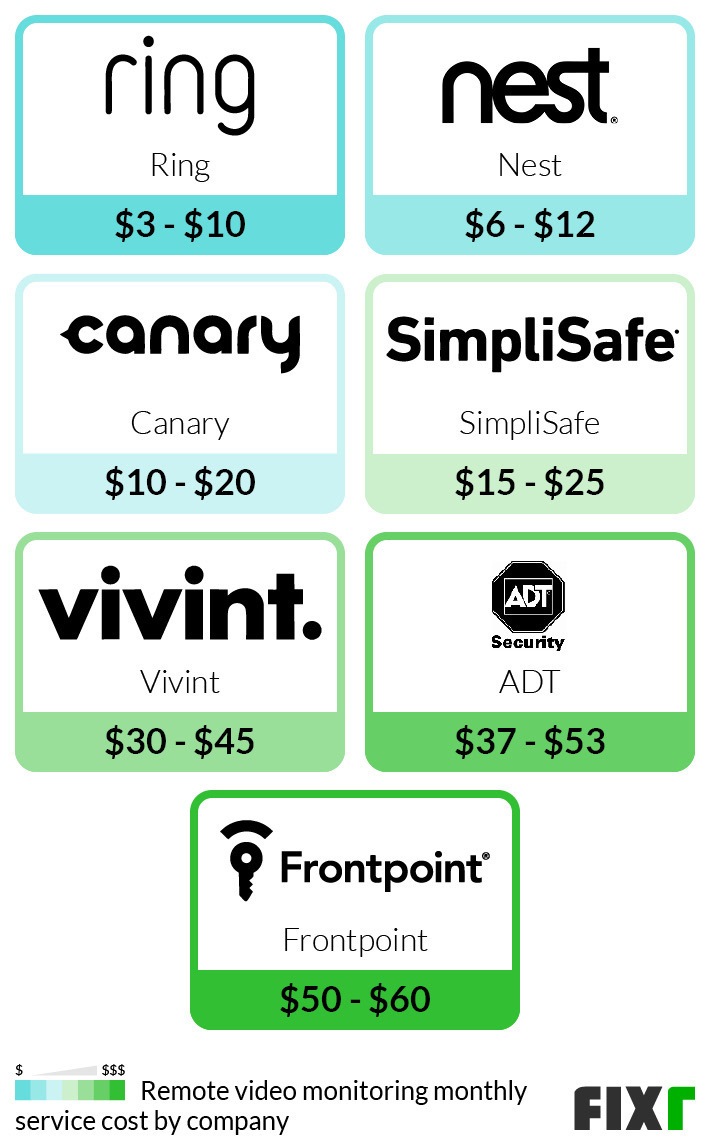
| Company | Average Cost (Monthly) |
| Ring | $3 - $10 |
| Nest | $6 - $12 |
| Canary | $10 - $20 |
| SimpliSafe | $15 - $25 |
| Vivint | $30 - $45 |
| ADT | $37 - $53 |
| Frontpoint | $50 - $60 |
Cost of Security Camera by Feature
You can expect to spend between $30 and $500 on cameras with extra features, depending on exactly what is included. Security cameras may have many different special features customers should consider when choosing one. Depending on your specific situation, certain features may provide more necessary capabilities needed to effectively monitor your space. Some features are pre-built into cameras, while others can be added afterward.
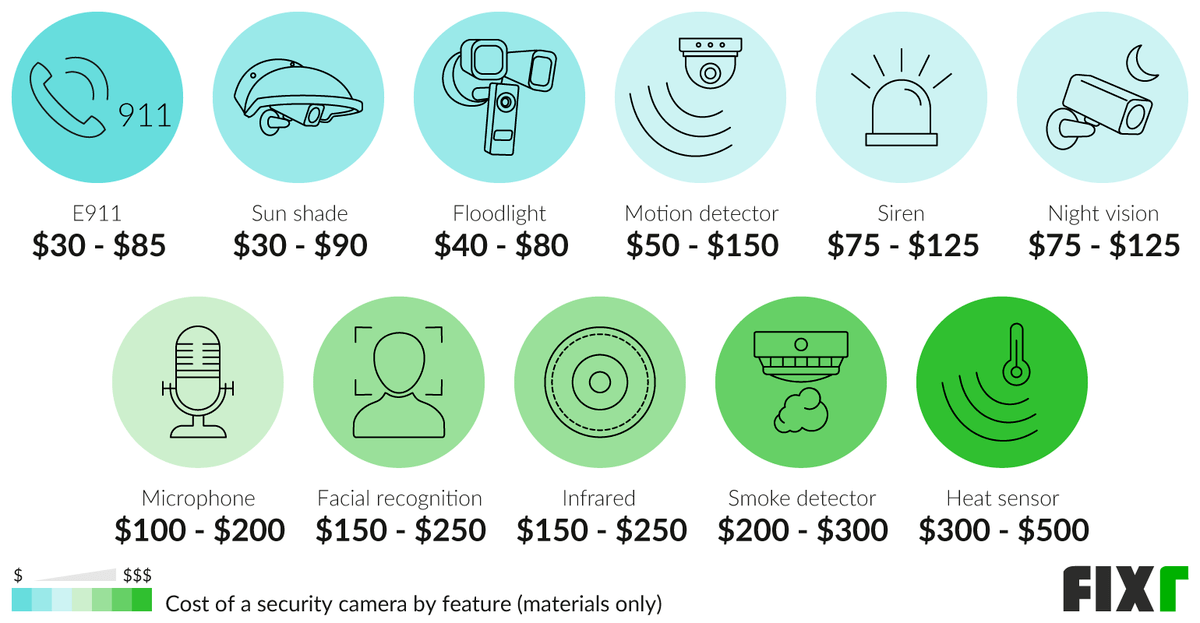
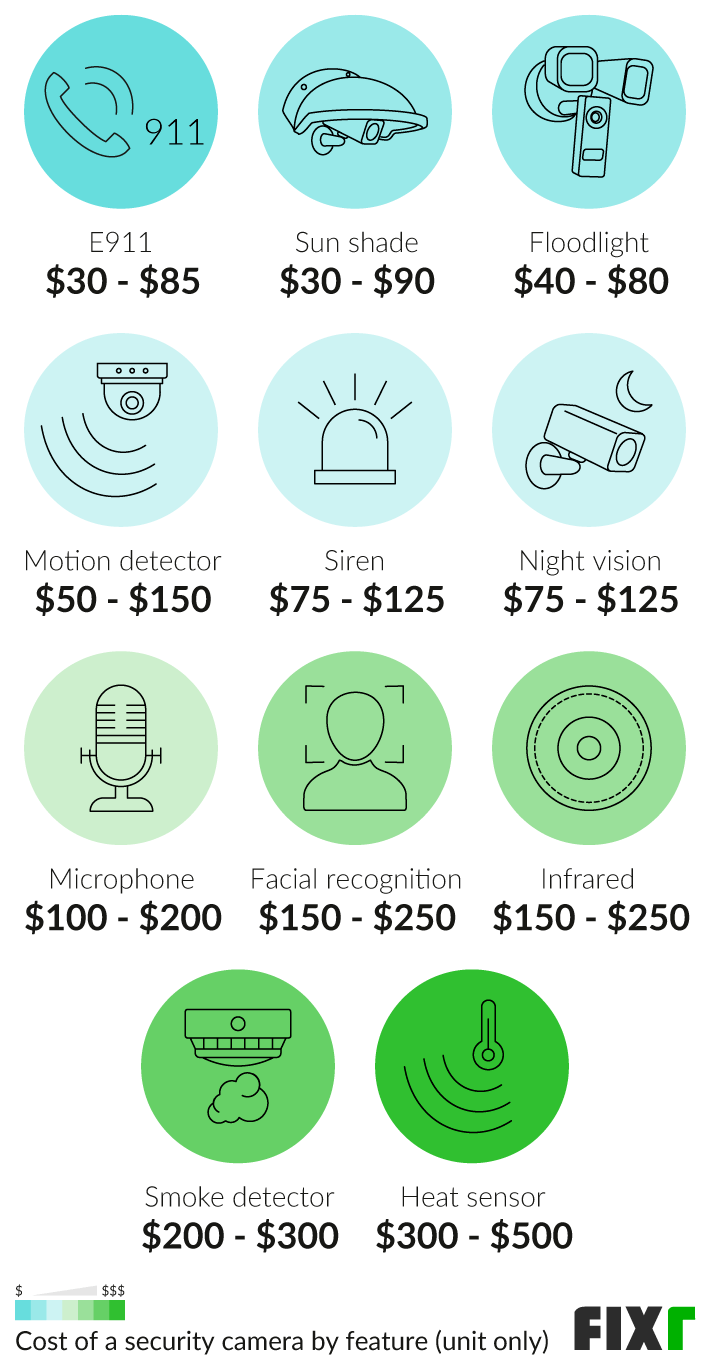
| Feature | Camera With Feature Cost (Unit Only) |
| E911 | $30 - $85 |
| Sun Shade | $30 - $90 |
| Floodlight | $40 - $80 |
| Motion Detector | $50 - $150 |
| Siren | $75 - $125 |
| Night Vision | $75 - $125 |
| Microphone | $100 - $200 |
| Facial Recognition | $150 - $250 |
| Infrared | $150 - $250 |
| Smoke Detector | $200 - $300 |
| Heat Sensor | $300 - $500 |
Security Camera 911 (E911)
Most cameras that include E911 services range from $30 to $85 for the camera only, with a monthly subscription fee of $30 to have the professional monitoring included. Security cameras with built-in 911-dialing features are usually only available as part of remote video monitoring service packages. Although many cameras offer built-in capabilities to contact 911, without a subscription, it requires the homeowner to actively monitor their own camera feeds at the time of the incident.
Security Camera Sun Shade
Security camera sun shades range from $30 to $90. They can be useful accessories for homeowners looking to prevent glare from the sun from making their footage hard to view. These shades are usually made out of resilient plastic material. In addition to shading from the sun, some sun shades are also built to protect from wind, rain, and other forms of precipitation. However, care should be taken during installation to make sure that the chosen shade is compatible with your camera and that the shade does not block the camera view.
Surveillance Camera Floodlight
Cameras with built-in floodlights cost $40 to $80. Surveillance camera floodlights are large lights either built into or next to a camera. These lights assist cameras in getting the best footage by shining a bright light on a specific area. These camera-based and camera-sized floodlights differ from normal floodlights since they integrate with the CCTV system feed. Many automatically turn on and illuminate an area when motion is detected, resulting in clearer footage in low-light scenarios.
Surveillance Cameras With Motion Detector
These cameras may be less expensive because they do not record at all times, costing between $50 and $150. Continuous monitoring is not the only way that a surveillance system works. You can also install cameras that turn on only once they sense movement. This cuts down on the operating costs of the camera, including electricity or battery power. Motion-sensing cameras can send an alert to your security company or your smartphone app when they are triggered, allowing you to get a feed just at the moment you need it, rather than all the time.
Outdoor Security Cameras With Siren
Security cameras with built-in sirens usually cost $75 to $125. Outdoor security cameras with sirens either included or installed later can be a helpful deterrent to alerting attention to a potential crime and for deterring criminals. Depending on the camera, system and user-determined individual settings, these siren-equipped security cameras can be set to automatically turn on whenever motion is detected or manually turned on and off by the homeowner via smartphone. Many also come equipped with police-style red and blue lights to give the impression of increased security.
Night Vision Camera
Night vision cameras range from $75 to $125. Night vision is usually built into cameras. However, it may be possible to buy some add-on night vision lenses for already purchased cameras. Night vision refers to cameras of various resolutions that produce clearer image quality during dark hours when most crimes occur. There are typically two ways night vision cameras make clear images in low light, active and passive. Active night vision cameras use a combination of infrared light, which is invisible to the naked eye, and a camera lens that can pick up infrared light and make a clear image. Passive night vision systems use regular lenses, but image-intensifying technology amplifies the existing light in the image to make a bright picture.
Security Camera With Mic
Cameras with microphones that are pre-installed generally cost $100 to $200. Today, more cameras come with built-in microphones for communication with pets, wanted guests, or even unwanted intruders. These cameras usually work with an app or Cloud-based system to allow for either one-way or two-way communication with the person being filmed by the camera. In addition to cameras with pre-installed microphones, some standalone microphones exist for installation to work with a pre-existing camera. These standalone microphones cost $20 to $35, plus installation.
Surveillance Camera With Facial Recognition
Facial recognition cameras average $150 to $250. Facial recognition is a feature built directly into some new cameras. Cameras with facial recognition have software that automatically scans footage for faces and, in some cases, even for specific faces. This technology is beneficial when paired with Smart systems. For example, some Smart cameras with facial recognition send mobile alerts when your face appears in footage. In addition, cameras with advanced or even basic facial recognition help identify suspects after a break-in, potentially speeding up the justice process.
IR (Infrared) CCTV Camera
IR, or Infrared CCTV cameras, cost around $150 to $250. IR cameras are cameras that use infrared technology to capture footage in dark situations. Infrared technology is similar to night vision technology, and many night vision cameras are referred to as IR cameras and vice versa. However, there are important differences. Some night vision cameras rely on at least some light and simply amplify that light in the footage feedback to brighten up the image, but infrared cameras work differently. They use infrared light to light up their subject. This infrared light is invisible to human eyes, but it is visible to the camera and provides a much clearer image even in no-light situations. Infrared cameras usually come with pre-installed lenses.
Motion-Activated Smoke Detector Camera
Motion-activated smoke detector cameras typically cost about $200 to $300. Motion-activated smoke detector cameras automatically detect, film, and potentially even alert you via mobile app when smoke is detected in the home. This Smart feature typically requires software that is usually only available pre-installed, not as an add-on. Homeowners may want to consider these for immediate notification in the event of a fire, allowing quicker emergency response.
Heat Sensor Security Camera
Homeowners who want heat sensor security usually buy specific heat sensor security cameras, which usually cost $300 to $500. Heat sensor cameras see heat instead of light, which allows them to detect intruders who may be in dark clothes that other cameras potentially cannot identify. This feature is not widely available on most cameras.
Maintenance
Security cameras require occasional maintenance to ensure that your security system is functioning at its best. One of the most important things is hardware maintenance - regularly keeping lenses clean, making sure outdoor devices and wires are protected, keeping cameras pointed in the right direction, and protecting power and WiFi connections.
Regular software updates are important for not only top performance but also to deter hacking and prevent other security issues. Many cameras offer automatic software update options, but checking if manual updates are necessary is a good idea. As cameras regularly come out with better resolutions and Smart features at more competitive prices, consider replacing your camera every 1-2 years to keep hardware up-to-date and enjoy increased security capabilities.
If your camera system was installed professionally and you are paying for a remote monitoring service, periodic professional maintenance will likely be included in the fees. If you do not use a monitoring service, perform the maintenance yourself. Yearly maintenance costs for testing your system for faulty connections, poorly aimed cameras, and for cleaning equipment like microfiber cloths and compressed air typically average $50 or less.
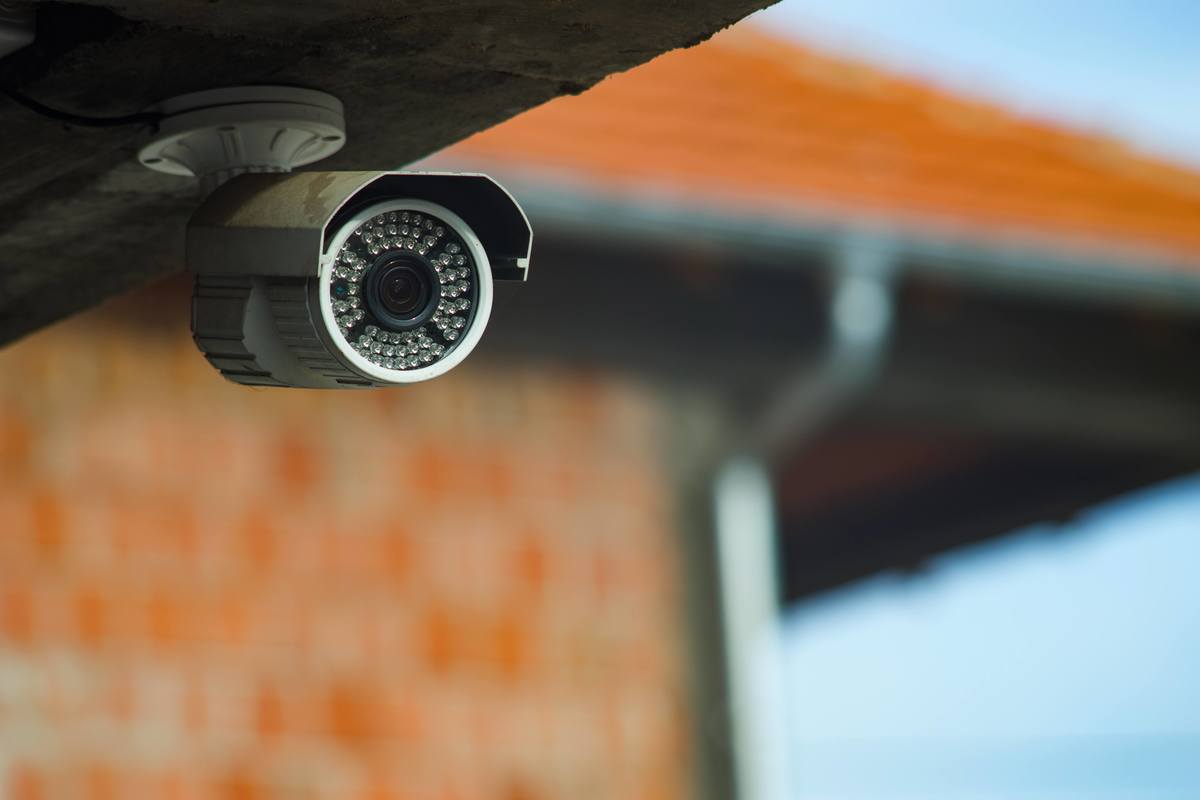
Where to Put Security Cameras
Many homeowners tend to place security cameras in locations known to see the highest percentages of crime attempts. Common places homeowners put security cameras include the front door, first-floor windows, and the back door. Beyond these specific areas, there are general best practices for camera placement to ensure the best security coverage. One tip is to place cameras in corners to get wider views of a room or area. Another tip is to place cameras where they will be camouflaged, either behind something or against a surface of a similar color.
On the other hand, depending on your security needs, you may want to place your camera(s) in an easily-visible, prominent location to give the impression of security and deter criminals. Lastly, with outdoor cameras, it is a good idea to consider placing cameras where they will be protected from weather and vandalism, such as in high-up or sheltered locations. Either way, it is always advisable to discuss the final placing of the cameras with the installation company.
Indoor vs Outdoor Security Camera
Outdoor cameras average $100 to $400 each, and indoor cameras average $50 to $250 each. Surveillance systems exist for both interior and exterior use. Some mixed-use cameras that can be used both indoors and out also exist. Generally, cameras meant to be installed outdoors have a longer range, better resolution, and weatherproofing features. Cameras intended for indoor use usually have wider fields of view and maybe even more Smart features for smart home system integration.


| Type | Camera Price (Unit Only) |
| Indoor | $50 - $250 |
| Outdoor | $100 - $400 |
Surveillance vs Security Camera
Surveillance cameras and security cameras are essentially interchangeable terms. Both protect your home and let you review footage of situations like attempted break-ins. Sometimes, the terms surveillance camera and security cameras can differentiate whether or not the system is being professionally monitored. For example, the term security cameras sometimes refers to cameras that are actively monitored in the event of a break-in, fire, or accident. Surveillance cameras sometimes refer to cameras monitoring your home, which can be only viewed on your smartphone.
Video Doorbell vs Security Camera
Video doorbells cost $75 to $150. Security cameras cost around $30 to $700. Most video doorbells combine a security camera, Cloud storage, Smart home functions, and a doorbell into one unit to address many home security needs in one device. However, video doorbells are fairly exclusively for use in door-mounted situations. Video doorbells are not easily repurposed for general security camera use. Security cameras are more traditional camera-based surveillance systems that may not have all the Smart features of video doorbells. However, many security cameras today also include these Smart features.


| Type of System | Price (Unit Only) |
| Security Camera | $30 - $700 |
| Video Doorbell | $75 - $150 |
Enhancement and Improvement Costs
Security Camera Concealment
Common concealment methods like hidden camera photo frames, hidden camera electrical outlets, and even common houseplants for camouflaging your camera cost $30 to $90. Security camera concealment is an important strategy in making your security system as effective as possible. Some homeowners hide cameras in corners, which decreases visibility and allows a better, wider angle for footage. Other techniques include hiding cameras behind objects or in areas colored similarly to the camera. On the other hand, some homeowners choose to put their cameras in a visible location to send the message to would-be criminals or trespassers that the area is under surveillance.
Pet Surveillance Camera
You can invest in a dedicated pet surveillance camera for your home at the cost of $35 to $250 or more, depending on the features you want and the model you choose. These cameras specifically monitor and/or interact with pets and can be installed in several places throughout the home. Many of these cameras allow you to monitor the activity from your smartphone or tablet to ensure that your furry friends are safe while you are away.
Additional Considerations and Costs
- Warranty and insurance. Having a licensed professional install your system guards against mishaps. With professional installation, the chances of an issue with camera wiring, power access, or recording device and footage access go down considerably. In addition, most professionals carry their own insurance against potential issues. If your security camera setup is an extensive, wired system setup, professional installation may provide a warranty.
- Home insurance. While you may get a break on your homeowner’s insurance for having a surveillance system installed, most insurances only cover you with professional monitoring and installation. Compare the monthly fees, peace of mind, and insurance reduction to see if this is the correct choice for your situation.
- Camera power. While some cameras have a built-in battery, they are not good for continuous use. Unless you use a motion-activated camera, having an outlet nearby helps.
- Legal concerns. In most states, it is legal to install a hidden camera with audio on your property. However, in some situations, audio may be considered wiretapping and could be illegal in your state. Check your state code before installing a camera with audio built-in.
- Mobile monitoring. Most cameras with in-home monitoring allow you to view the feed on your tablet or phone for no cost. However, some professional monitoring companies may charge an extra fee of $10 a month to view the same feed. Check with your company to find out more.
- DIY. DIY installation of 4 wireless cameras is very common, costing around $350 to $700 for the entire setup. However, to ensure proper installation, the best option is to hire an experienced professional who will ensure the cameras are set up properly, and all the appropriate connections are functioning.
- Burglars. Many homeowners use cameras not only to prevent burglaries but also to catch burglars if a break-in happens. Cameras with features like motion detection, night vision, and facial recognition help produce footage capable of detecting things like clothing, facial details, and other pieces of information to help catch criminals and regain losses.
- Number of units. When deciding how many cameras you need, take into account how many rooms or outdoor sides of your house you want to cover, as well as the different angles of your house. Angles significantly impact the field of view. In addition, depending on the size of certain rooms, they may require more than one camera to survey the entire room.
- Financing. There may be the option to finance a surveillance system through the retailer or seller of the system or a bank. The retailers typically do not have many upfront financing fees, but banks have origination fees that range from 1% to 6%, based on your credit and other factors.
FAQs
- How much does it cost to install a home security system?
The costs associated with a home security system vary widely by size and type. Basic DIY wireless systems can cost as little as $70 for a couple cameras, whereas more advanced systems like wired CCTV systems with a professional monitoring service have an average cost between $700 and $1,900 for installation and materials.
- How much does it cost for a home alarm system?
Home alarm systems combine both a security camera network and professional outsourced monitoring by a company, often on a 24/7 basis. The average cost of monthly monitoring is around $30, while the initial setup and installation costs run between $1,300 or more.
- How do you install a security system?
Every security system is different. Your best option is to contact a professional who can assist you in choosing the right one and getting it set up properly. However, you can find wireless cameras that you can link to your tablet to monitor your front door or another area of your home in a DIY setup.
- How do outdoor security cameras get power?
Outdoor security cameras typically get their power from a wired connection to an electrical outlet. However, some outdoor cameras known as wire-free outdoor cameras operate based on battery power. There are clear advantages and disadvantages to power from a wired connection and power from batteries. Power from a wired connection eliminates the need to change batteries regularly. However, powering your camera from an outlet means you can only place your camera in areas where outlets are close by. On the other hand, the batteries in battery-powered cameras must be changed relatively often, creating additional labor considerations, but battery-powered cameras can also be placed virtually anywhere, allowing more flexibility and increased coverage.
- Where is the best place to put security cameras?
Many homeowners place security cameras in locations known to see the highest percentages of crime attempts. Common places homeowners put security cameras include the front door, first-floor windows, and the back door. More generally, homeowners should try to place their cameras in corners to get wider angles and capture more details in their footage. In addition, homeowners may want to consider concealing their cameras in hard-to-see places, such as in similarly colored areas or behind or inside objects. On the other hand, homeowners may consider putting cameras in obvious and highly visible places to send a deterring message to criminals that their home or property is under surveillance.
- How long do batteries last in security cameras?
Battery life in security cameras varies. Some security cameras have backup batteries that last for 24 hours in a power loss. Some wire-free cameras have battery lives of 48 hours or more.
- Do security cameras record all the time?
Some security cameras record all the time. However, to conserve memory storage space, many modern security cameras have software that only starts recording when motion or noise is detected. The majority of cameras and Cloud storage services on the market today default to making and keeping recordings when motion is detected - this saves memory storage space and bandwidth and keeps homeowners from having to scroll through hours of uneventful footage. However, some homeowners with advanced security needs and increased storage budgets opt to record all the time to ensure complete security coverage in an emergency.
References
- ADT Security. “ADT monitoring packages and prices."
https://www.adtsecurity.com/adt-prices-and-packages - Amazon. “Surveillance Cameras.”
https://www.amazon.com/Surveillance-Cameras/b?ie=UTF8&node=898400 - Craftsman Book Company. National Electrical Estimator, Ed. by Mark C. Tyler (Carlsbad, CA, 2021).
- FIXR Cost Guides and Cost Database.
- Frontpoint. “Home Security Packages."
https://www.frontpointsecurity.com/shop/monitoring - Hikvision. “About us.”
https://www.hikvision.com/en/about-us/ - How-to Geek. “Should You Buy a Video Doorbell?"
https://www.howtogeek.com/276969/should-you-buy-a-video-doorbell/ - Real Homes. “Smart security cameras: do you really need them?"
https://www.realhomes.com/us/advice/do-you-really-need-smart-home-security-cameras - Reolink. “Security Cameras with SD Card – Best Buying Guide."
https://reolink.com/security-camera-with-sd-card/ - Safewise. “Best Home Security Cameras for 2021."
https://www.safewise.com/resources/home-security-cameras/ - Safewise. “The Top 8 Reasons to Get a Home Security System."
https://www.safewise.com/blog/top-8-reasons-get-home-security-system/ - Security.org. “Video Doorbell Cameras Guide."
https://www.security.org/doorbell-camera/ - Swann. “Introducing Swann.”
https://www.swann.com/us/company/about-swann - Tech Radar. “Best 360 camera 2021: 10 cameras to capture everything."
https://www.techradar.com/news/best-360-degree-camera - The New York Times. “The Best Outdoor Security Camera."
https://www.nytimes.com/wirecutter/reviews/best-wireless-outdoor-home-security-camera/ - U.S. News. “Wired vs. Wireless Home Security Cameras."
https://www.usnews.com/360-reviews/security-cameras/wired-vs-wireless#wired-pros-cons - Vivint. “Vivint Pricing & Home Security Packages."
https://www.vivintsource.com/packages
